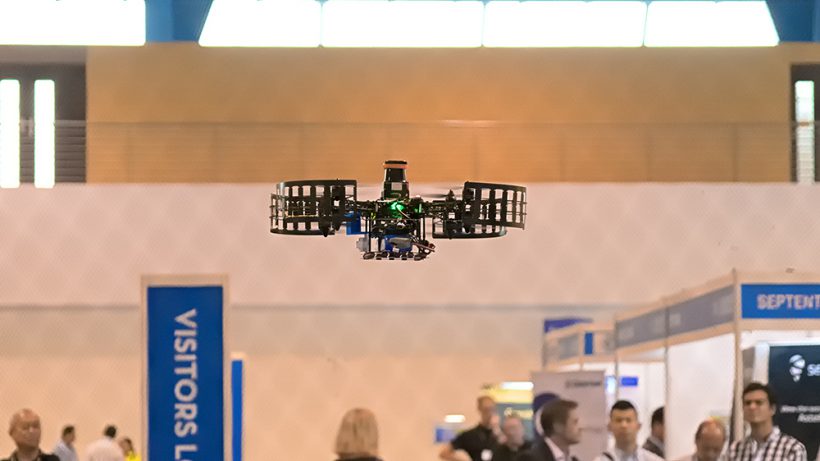In the last few years, recreational and commercial drone flying has picked up at an exponential rate, thanks to the economies of scale of drone technology development. Recreational droning has especially grown, and in space-constrained Singapore, this is of particular concern as this may pose a risk to both aviation and public safety. In this article, MAphotoSG takes a basic look at how recreational droning can be carried out safely and in accordance with Singapore’s Air Navigation Act (Chapter 6).

In the Singapore context, a drone is a common term for an unmanned aircraft (UA), and an unmanned aircraft system (UAS) consists of both the UA and its related equipment, such as the remote control or transmitter. An UA is essentially defined as an aircraft operated without a pilot on board. Before purchasing or flying a UA, users are strongly advised to read and understand the rules for such operations, so as to ensure a safe environment for all.

Potential Dangers of Unsafe Droning
Collision incidents involving drones and aircraft have fortunately been extremely rare, but the effects of such collisions have been tested and studied by various bodies. In a 2016 study conducted by the UK’s Department for Transport, Military Aviation Authority and British Airline Pilot’s Association, it was found that both birdstrike and non-birdstrike certified helicopter windscreens can be critically damaged at normal and below cruise speeds. Helicopter tail rotors are also very vulnerable to drone impacts, even with smaller drone components. While airliner windscreens are much more resistant, critical damage can occur at high impact speeds with drones in the 4kg class.
 Aftermath damage of a 320km/h drone strike test on an aircraft radome (Photo credit: Cranfield University)
Aftermath damage of a 320km/h drone strike test on an aircraft radome (Photo credit: Cranfield University)
Drones can also be ingested by air intakes and cause significant engine damage to both civil and military aircraft engines, or even a loss of flight power, which can result in a fatal crash. The danger of falling debris can also impact on populated areas and cause further damage, injuries or fatalities on the ground. It is therefore imperative that a safe environment be maintained and regulated to ensure such incidents do not occur.
CAAS Permits
There are two types of permits which may be required by the Civil Aviation Authority of Singapore (CAAS) for UA operations under certain conditions. It is important that the proper permit is applied for to ensure regulatory compliance.

No permits are required if the UA is flown under the following conditions:
1. Recreational or research UA activity.
2. Total UA weight is 7kg or less.
3. Outside 5km of any airport or military airbase
4. At a height of not more than 200ft (60m) AMSL
5. UA does not discharge or carry any foreign items
6. Not flown in a dangerous, prohibited or restricted area.
Operator Permit
As part of the requirement for applying this annual permit, the applicant must be able to ensure the safe operation of the UA, including the competency of the operator, safety manegement procedures such as risk assessments, and the airworthiness of the UA. This permit is required for the following operations:
1. Non-recreational or non-research (e.g. commercial or specialised services, including photography or videography) UA activity, regardless of weight
OR
2. Recreational or research purpose where the UA weighs more than 7kg. A Class 1 Activity Permit is also required for this operation.
Activity Permit Class 1 and Class 2
This permit is required for a single activity or block of repeated activities to be performed by an UA at a specific area of operation, with specific operational profiles and conditions. A Class 1 Activity Permit is required for any activity which requires an Operator Permit.
A Class 2 Activity Permit is required under the following conditions:
1. Recreational or research UA activity.
2. Total UA weight is 7kg or less.
3. Within 5km of any airport or military airbase
4. At a height of more than 200ft (60m) AMSL
5. Within any dangerous, prohibited or restricted area.
Please note that there are other permits which may be required from other agencies for certain aspects of UA operations. For example, aerial photography or overflights of security-sensitive locations comes under the purview of the Singapore Police Force. Any radio frequencies usage or power limits other than those listed in IMDA’s short range devices guidelines will have to be approved by IMDA. Please check with the relevant agencies for the up-to-date requirements and permits.
During major national public events, such as the National Day Parade (NDP), the CAAS and the Singapore Police Force will issue advisories on temporary restricted areas at the main event and surrounding areas. UAs are not allowed to be brought in or operated without a valid permit, and offenders found in possession of such items will be arrested, and if convicted, be liable to an imprisonment term of up to 12 months, a fine of up to $20,000, or both. Please refer to such advisories for events which will be published and broadcasted in the media.
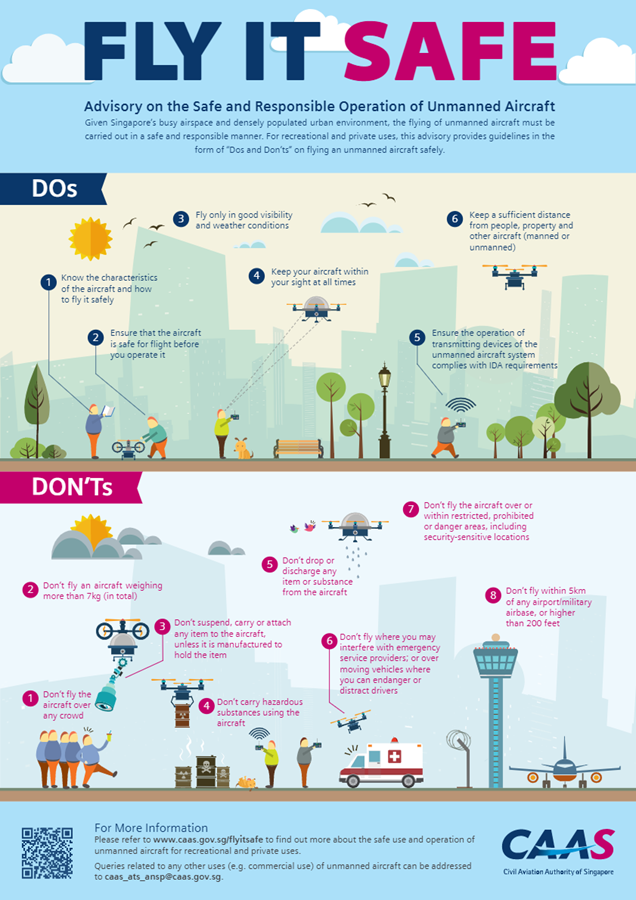
CAAS Fly It Safe Checklist
DOs
1. Familiarise and know your UA and UAS, and how to operate and fly it safely.
2. Do a preflight check on the UAS before operating it. Pay particular attention to any cracks or damage to the UA which may render it unsafe.
3. Operate the UA in good visiblity and weather conditions. Avoid flying in strong winds, heavy rains or hazy situations.
4. Ensure that the UA is always flying within your sight at all times.
5. Check that the UAS transmitting equipment complies with the Infocomm Media Development Authority (IMDA) requirements.
6. Ensure that the UA is operated with sufficient clearance from people, properties or other aircraft (manned or unmanned).
DON’Ts
1. Don’t fly the UA over any crowds. It will pose a danger should it fail and be in an uncontrolled drop.
2. Don’t fly a UA weighing more that 7kg in total.
3. Don’t attach or suspend any attachments to the UA that is not approved by the manufacturer.
4. Don’t carry any hazardous substances with the UA.
5. Don’t drop any item or substance from the UA while in flight.
6. Don’t interfere with emergency service providers, or fly over moving vehicles. You can endanger or distract the parties in those situations.
7. Don’t fly the UA over or within dangerous, prohibited or restricted areas.
8. Don’t fly within 5km of any airport or military airbase, or higher than 200ft (60m) Above Mean Sea Level (AMSL).
Safe UA Flying Areas
To ensure that the UA flys within a safe area, please refer to the OneMap.sg site, and click on the “Nearby” tab, and “Safety and Security section to view the areas within 5km of airports and military airbased, or dangerous, prohibited and restricted areas. Please take note that under the National Parks Board (NParks) guidelines, UAs are not allowed to be flown at certain parks and nature reserves the agency oversees, such as the Botanic Gardens. One of the most popular option for UA flying is the Marina Barrage, which offers good photography options such as of the city skylines.
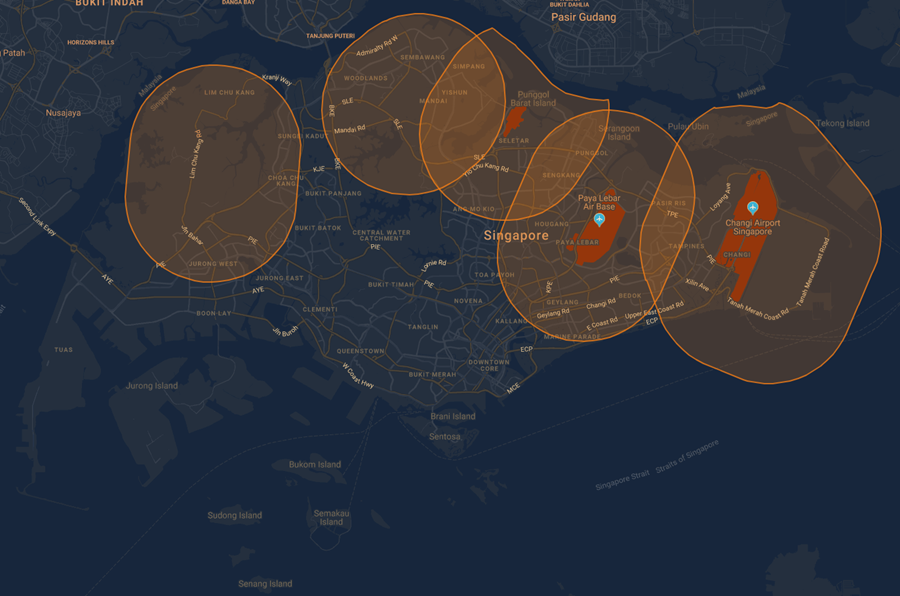 No fly zones located up to 5km from civil airports and military airbases in Singapore.
No fly zones located up to 5km from civil airports and military airbases in Singapore.
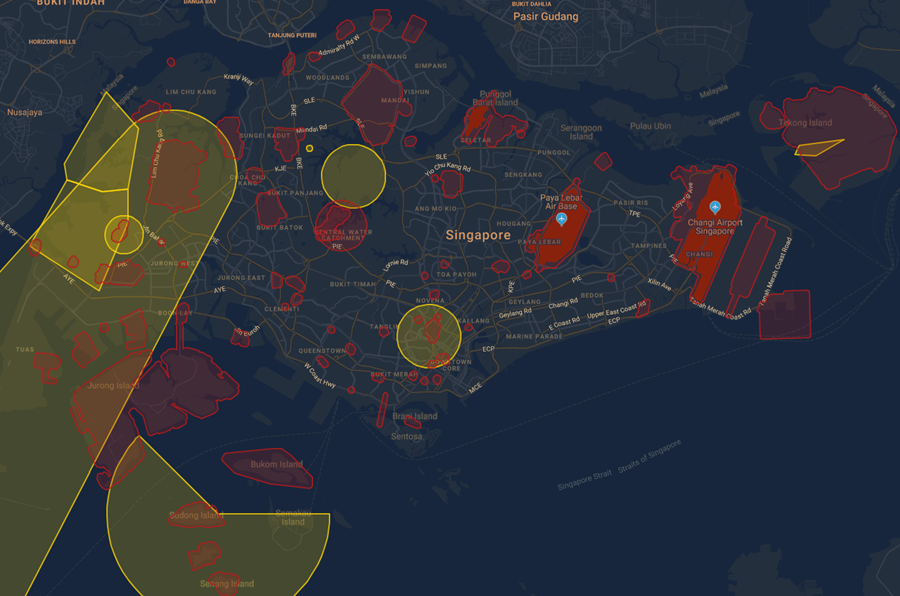 Dangerous & Restricted (Yellow zones) and Protected & Prohibited (Red zones) no fly zones in Singapore.
Dangerous & Restricted (Yellow zones) and Protected & Prohibited (Red zones) no fly zones in Singapore.
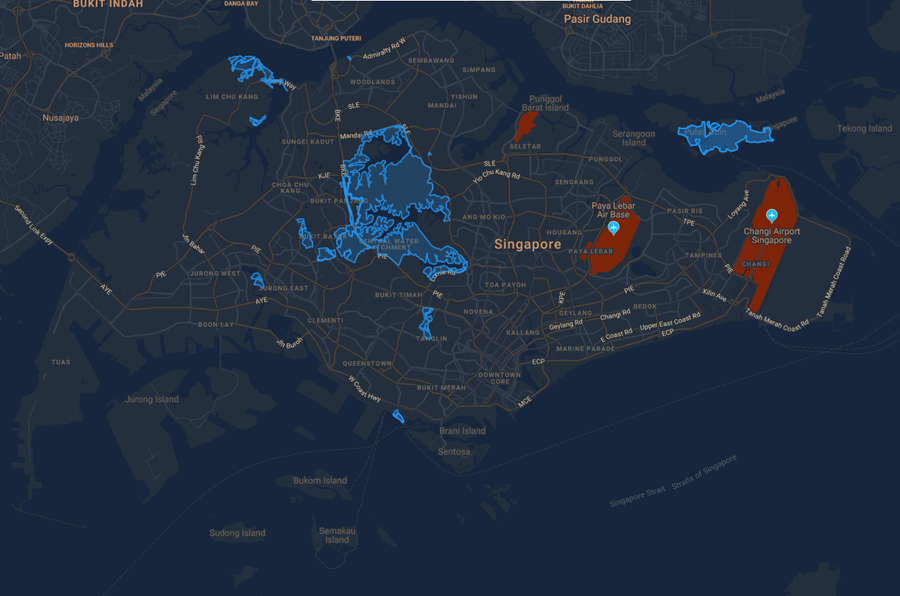 National Parks Board parks & nature reserves with “No Flying” signs.
National Parks Board parks & nature reserves with “No Flying” signs.
Further References
To keep up to date with the latest UA operation regulations and requirements in Singapore, please refer to the following sources of information. Note that this is not an exhaustive list, and all information presented are subjected to change by the relevant organisations.
Singapore Air Navigation Act:
https://sso.agc.gov.sg/Act/ANA1966
Civil Aviation Authority of Singapore – UAS Section:
https://www.caas.gov.sg/public-passengers/unmanned-aircraft-systems
Civil Aviation Authority of Singapore – UA Permits:
https://www.caas.gov.sg/public-passengers/unmanned-aircraft-systems/permit-application
Infocomm Media Development Authority – Operation of UAS:
https://www.imda.gov.sg/regulations-licensing-and-consultations/frameworks-and-policies/spectrum-management-and-coordination/frequency-allocation-and-assignment/operation-of-unmanned-aircraft-systems-uas
OneMap.sg:
https://www.onemap.sg/main/v2/

